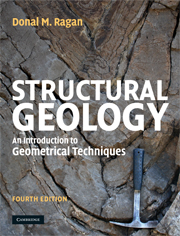Book contents
- Frontmatter
- Contents
- Preface
- Acknowledgements
- 1 Structural planes
- 2 Thickness and depth
- 3 Lines and intersecting planes
- 4 Planes and topography
- 5 Stereographic projection
- 6 Rotations
- 7 Vectors
- 8 Faults
- 9 Stress
- 10 Faulting
- 11 Deformation
- 12 Strain
- 13 Flow
- 14 Folds
- 15 Parallel folds
- 16 Similar folds
- 17 Folds and topography
- 18 Structural analysis
- 19 Tectonites
- 20 Drill hole data
- 21 Maps and cross sections
- 22 Block diagrams
- Appendices
- References
- Index
11 - Deformation
Published online by Cambridge University Press: 05 June 2012
- Frontmatter
- Contents
- Preface
- Acknowledgements
- 1 Structural planes
- 2 Thickness and depth
- 3 Lines and intersecting planes
- 4 Planes and topography
- 5 Stereographic projection
- 6 Rotations
- 7 Vectors
- 8 Faults
- 9 Stress
- 10 Faulting
- 11 Deformation
- 12 Strain
- 13 Flow
- 14 Folds
- 15 Parallel folds
- 16 Similar folds
- 17 Folds and topography
- 18 Structural analysis
- 19 Tectonites
- 20 Drill hole data
- 21 Maps and cross sections
- 22 Block diagrams
- Appendices
- References
- Index
Summary
Introduction
Processes acting within the earth at various times and places cause bodies of rocks to be displaced from the sites of their origin. After such displacements the bodies have different locations and orientations, and also commonly different shapes and sizes. Such bodies are said to be deformed. Although it is ultimately necessary to treat these changes in a full three-dimensional setting, many situations can be approached from a consideration of just two, and this also serves as a useful way to introduce the subject.
Even in two dimensions, the complete geometrical description of the deformed state for a relatively simple structure may be quite involved. Imagine a rectangular block composed of sedimentary strata (Fig. 11.1a). As the result of a general deformation, original lines become curvilinear, original planes curviplanar and original parallel lines and planes are no longer parallel (Fig. 11.1b). Such a deformation is inhomogeneous.
The description of a deformation consists of comparing the initial and final configurations of the body with emphasis on the changes which have occurred. To facilitate this comparison we refer the body in its initial place, orientation, shape and size to material coordinates (x, y) and its final place, orientation, shape and size to spatial coordinates (x′, y′). Every material point or particle P(x, y) in the body is displaced to spatial point P′ (x′, y′). Each point P′ is related to its particle P by a displacement vectoru.
- Type
- Chapter
- Information
- Structural GeologyAn Introduction to Geometrical Techniques, pp. 269 - 301Publisher: Cambridge University PressPrint publication year: 2009



